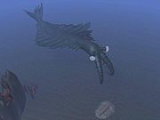
Dinocarida
Encyclopedia
DinocarididaGreek, "Terrible crabs" – sometimes informally spelt Dinocarida, but the second 'id' is linguistically correct – see is a proposed extinct
taxon of fossil
arthropod
-like marine animals found in the early and middle Cambrian
. It is subdivided into the anomalocarid
s and the opabinid
s. The name of this group comes from Greek, "deinos" and "caris," meaning "terror shrimp" or "terror crab," due to their crustacean-like appearance and the hypotheses suggesting that members of this class were the apex predators of their time.
Dinocaridids are bilaterally symmetrical, with a non-mineralized cuticle
and a body divided into two major tagmata
, or body-sections. The frontal section should have one or more claws found just in front of the mouth, which is located on these creatures' underside. The body will possess thirteen or more segments, each with its own gill branch and swimming lobe. It is thought that these lobes moved in an up-and-down motion to propel the animal forward in a fashion similar to the cuttlefish
.
The placement of Dinocaridida is uncertain: they appear to be a stem group to arthropods. In some recent works they are grouped with other enigmatic forms in the phylum Lobopodia
.
The group is geographically widespread, and has been reported from Cambrian strata in Canada, China and Russia, as well as the Devonian of Germany.
Extinction
In biology and ecology, extinction is the end of an organism or of a group of organisms , normally a species. The moment of extinction is generally considered to be the death of the last individual of the species, although the capacity to breed and recover may have been lost before this point...
taxon of fossil
Fossil
Fossils are the preserved remains or traces of animals , plants, and other organisms from the remote past...
arthropod
Arthropod
An arthropod is an invertebrate animal having an exoskeleton , a segmented body, and jointed appendages. Arthropods are members of the phylum Arthropoda , and include the insects, arachnids, crustaceans, and others...
-like marine animals found in the early and middle Cambrian
Cambrian
The Cambrian is the first geological period of the Paleozoic Era, lasting from Mya ; it is succeeded by the Ordovician. Its subdivisions, and indeed its base, are somewhat in flux. The period was established by Adam Sedgwick, who named it after Cambria, the Latin name for Wales, where Britain's...
. It is subdivided into the anomalocarid
Anomalocarid
AnomalocarididsNeolatin compound word from Greek ἀνώμαλος anomalos and καρίς karis , meaning "strange shrimp". Note that while "Anomalocarid" is a widely used alternative spelling, the double "id" at the end is technically the correct form, for the reasons given in...
s and the opabinid
Opabinid
Opabinids are organisms resembling the Burgess shale creature Opabinia, and by inference related to it. The status of the group and its constituent members are very much up in the air, as are the group's relationships with other organisms: some posit a close relationship with the...
s. The name of this group comes from Greek, "deinos" and "caris," meaning "terror shrimp" or "terror crab," due to their crustacean-like appearance and the hypotheses suggesting that members of this class were the apex predators of their time.
Dinocaridids are bilaterally symmetrical, with a non-mineralized cuticle
Cuticle
A cuticle , or cuticula, is a term used for any of a variety of tough but flexible, non-mineral outer coverings of an organism, or parts of an organism, that provide protection. Various types of "cuticles" are non-homologous; differing in their origin, structure, function, and chemical composition...
and a body divided into two major tagmata
Tagma (biology)
In invertebrate biology, a tagma is a specialized grouping of arthropod segments, such as the head, the thorax, and the abdomen with a common function. The segments of a tagma may be either fused or moveable.-Tagmata:...
, or body-sections. The frontal section should have one or more claws found just in front of the mouth, which is located on these creatures' underside. The body will possess thirteen or more segments, each with its own gill branch and swimming lobe. It is thought that these lobes moved in an up-and-down motion to propel the animal forward in a fashion similar to the cuttlefish
Cuttlefish
Cuttlefish are marine animals of the order Sepiida. They belong to the class Cephalopoda . Despite their name, cuttlefish are not fish but molluscs....
.
The placement of Dinocaridida is uncertain: they appear to be a stem group to arthropods. In some recent works they are grouped with other enigmatic forms in the phylum Lobopodia
Lobopodia
Lobopodia is a group of poorly understood animals, which mostly fall as a stem group of arthropods. Their fossil range dates back to the Early Cambrian. Lobopods are segmented and typically bear legs with hooked claws on their ends....
.
The group is geographically widespread, and has been reported from Cambrian strata in Canada, China and Russia, as well as the Devonian of Germany.

